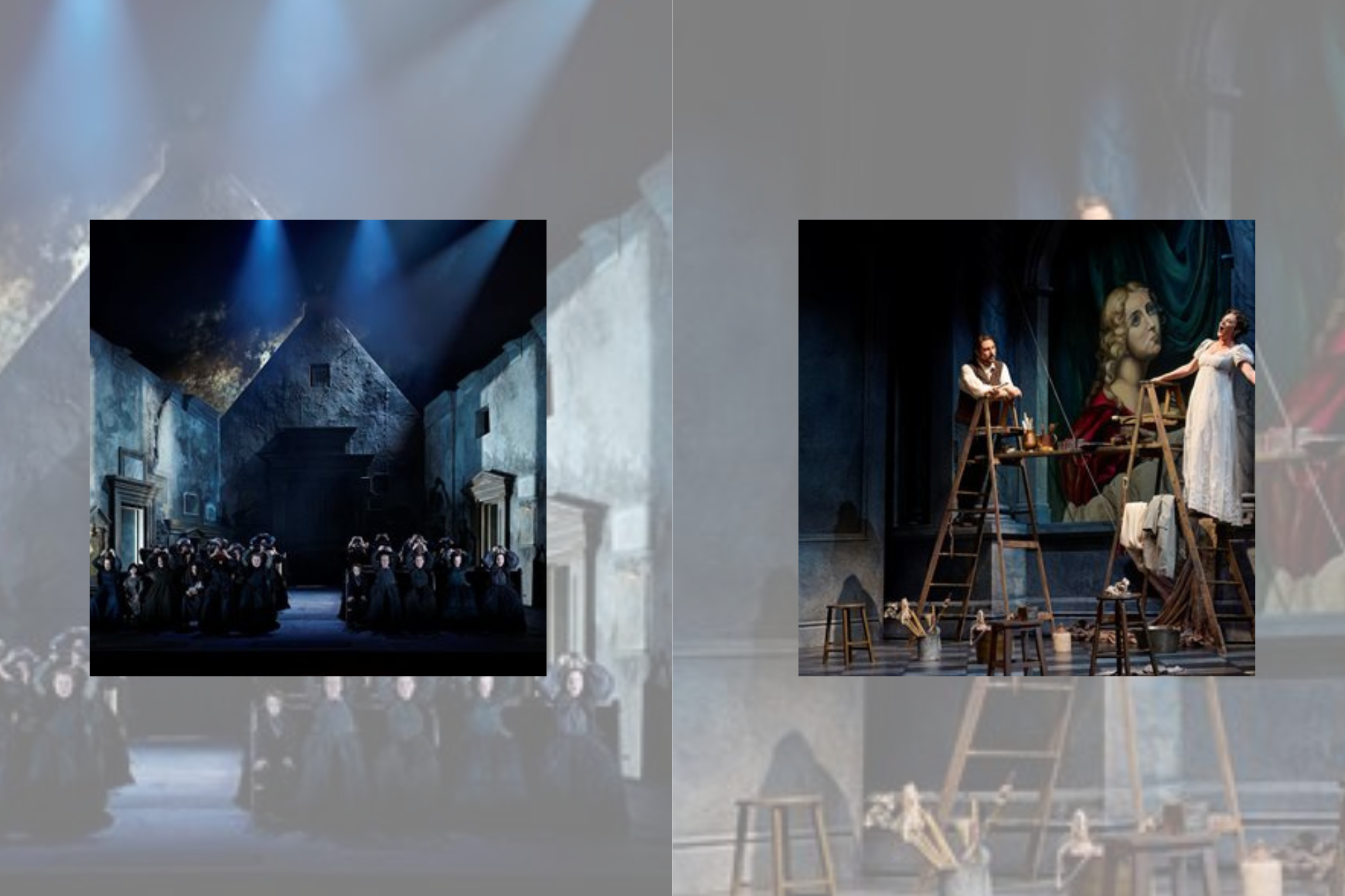REVIEW: Tosca and Macbeth at Canadian Opera Company
The spring season at the Canada Opera Company has offered audiences two contrasting, but complementary, romantic opera experiences. While the production of Puccini’s Tosca, which first premiered in 2017, is opulent and lush both visually and sonically, Verdi’s Macbeth, a brand-new production, is gritty and dark. Both provide subtle but pointed critiques of religion and moral corruption.
Puccini’s opera, one of the most beloved works in his repertoire, tells the story of an opera singer, Tosca, whose love for the artist Cavaradossi is thwarted by the jealous and corrupt Scarpia, the Roman chief of police. Scarpia seeks to execute Cavaradossi for hiding his friend Angelotti, an escaped political prisoner. Scarpia pressures Tosca to give herself to his lust in exchange for Cavaradossi’s life. Tosca agrees, only to murder Scarpia before he ravishes her.
The opening chords of Tosca, full and heavy like velvet drapes, establish the atmosphere of the evening. The orchestra, under the baton of Giuliano Carella, maintains this deep, rich quality of sound throughout the two-hour and thirty-five-minute opera.
The accomplished singers expertly match this luxurious tone. Keri Alkema as Tosca and Stefano La Colla as her lover Mario Cavaradossi offer pitch-perfect, passionate performances, complementing each other well but shining in their own rights, too.
The second act maintains the luscious aesthetics established in Act One with a plush and luxurious set, designed by Kevin Knight, who also designed the costumes. The posh, stately Napoleonic sitting room and office of the corrupt Baron Scarpia is a perfect backdrop for Tosca, who wears an extravagant gown and cape adorned with jewels, having just sung for crowds celebrating Napoleon’s defeat at the Farnese Palace.
The third act matches the theatricality of the first two with its thrilling conclusion. Set behind the ramparts of the Castello Sant’Angelo, the opera concludes dramatically when Tosca, after discovering the evil chief of police has lied and did not ever plan to fake the execution of Cavaradossi as he promised, throws herself off the top of the ramparts to her death to escape imprisonment for murdering the corrupt Scarpia.
This production of Tosca offers the grandeur many fans of romantic opera know and love without distracting from the beautiful music, compelling story, and dramatic scenarios. The spectacle, while glorious, does not overwhelm the beating heart of the score and libretto.
In contrast to the lavishness of Tosca, Macbeth is set in the neglected ruins of a Scottish rural chapel establishing a decrepit, ghostly atmosphere. In contrast to the various locations for the action listed in Shakespeare’s original script, the chapel in this production (designed by John Macfarlane) stands in for the castle of Macbeth, a battlefield, and other locations in the story.
Macbeth opens with a chorus of witches who sway back and forth as they pore over prayer books as if possessed. The coven’s creepiness is complemented by three shabbily dressed but eerily pale children who act as the witches’ surrogates by standing in for their three prophecies.
Quinn Kelsey, who sings the role of Macbeth, is particularly compelling in his embodiment of the inner turmoil of a man pulled toward glory and fame by ambition but ultimately held back by his sense of morality. Alexandrina Pendatchanska, who sang the role of Lady Macbeth at the performance I saw, was not as commanding a presence as one might expect in this iconic role, but performed competently and efficiently.
The gory details of the story are, unsurprisingly, some of the most theatrical moments of the production. When Macbeth returns from murdering Duncan, carefully holding out his bloody hands, which drip in red, it’s a chilling sight.
This violence continues when Macbeth, with a gang of brooding and intimidating assassins, plans to murder Banquo, who has been prophesied by the witches to be the father of the future line of kings.
In the banquet scene, right after Macbeth is informed Banquo has been murdered, the ghost of Banquo, distinguished with a bright white light, in contrast to the warm candle-lit atmosphere of the banquet hall, stalks Macbeth with a ghostly and bloody presence.
Throughout the production, designer David Finn sets the mood with shadowy lighting. His dank and adumbral design maintains the ghostly terror throughout the production while never being too dark for the audience to miss the action and emotion of the performance.
The third act, outdoing the terrifying images of the first two, begins with bodies spilled from their coffins as the witches make their second appearance, sharing a second set of prophecies with the anxious, conflicted Macbeth.
Despite their differences in atmosphere, both productions of Tosca and Macbeth employ the mise-en-scène to provide cutting social commentary albeit in distinct, but theatrical, ways.
In Tosca, the first small indication that religion is in this production’s crosshairs comes at the end of Act One. Set in the chapel of the church of Sant’Andrea della Valle, a menacing mass procession marches steadily down the raked stage in a trance, creating the sense this unstoppable force will overwhelm and suffocate the audience they are slowly approaching.
The evil and corrupt Scarpia is one of Tosca’s obvious points of narrative critique. Cavaradossi tells us that Scarpia is a “licentious bigot who exploits the uses of religion as refinements for his libertine lust.”
More softly, in this production, Tosca murders the evil Scarpia with the blade of a letter opener that doubles as a bejewelled crucifix that adorns Scarpia’s desk. Religion here is metaphorically and literally an instrument of violence.
The representation of religion and the church as an instrument of violence and death is further established in the last moments of the opera when Tosca, after having lost her lover Cavaradossi due to Scarpia’s double-dealing, sings “O Scarpia, we meet before God!” before throwing herself off the ramparts.
In Macbeth, director Sir David McVicar and his design team critique religion by making the House of God, the chapel where the action of the production is set, the literal place of violence and death that drives the action of Shakespeare’s tragedy.
At one point, this commentary is made explicit when an assassin rips pages from the chapel’s bible as they plot the murder of Banquo.
Tosca and Macbeth offer audiences contrasting but ultimately rich opera experiences, sonically, visually, and intellectually. Despite the slight disappointment in Lady Macbeth’s performance, the singing and acting of the other performers were stellar. The sets and costumes, though opposite in quality and characteristic, offer audiences a theatrical visual experience. And the critique of religion gives the audience something to meditate on.
Be it the lush and extravagant production of Tosca or the brooding and eerie production of Macbeth, both operas capture the spirit of romantic opera to delight audiences.
Macbeth runs at the Canadian Opera Company through May 20. Tosca runs at the Canadian Opera Company through May 27. Tickets are available here.
Intermission reviews are independent and unrelated to Intermission’s partnered content. Learn more about Intermission’s partnership model here.














Comments